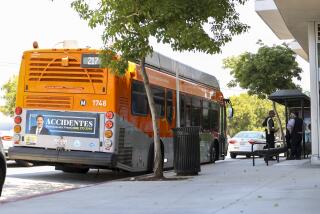When Charles Maclay submitted a township map...
- Share via
When Charles Maclay submitted a township map to the Los Angeles County recorder in September 1874, he named the new community, like the San Fernando Valley itself, after the nearby San Fernando Mission.
And although San Fernando was not officially incorporated until Aug. 31, 1911, Maclay’s dream of establishing a town near the base of the San Fernando mountains was virtually assured when Southern Pacific Railroad completed a line through the area in December 1874.
For years, San Fernando thrived as a bustling rail town. Unlike other Valley communities that succumbed to annexation by Los Angeles after the Los Angeles Aqueduct was completed in 1913, San Fernando possessed its own supply of well water and was able to resist the pull of its mammoth neighbor, whose borders would eventually expand to surround the municipality.
Now, 122 years after its founding, San Fernando residents continue to take pride in the city’s image as a low-key, small-town community hidden among the suburban sprawl of the northeast Valley.
Neighborhoods of single-family homes, busy parks, a small police force and a tree-lined outdoor shopping mall help reinforce its small-town image. This is an image that persists despite the encroachment in recent years of big city-like problems such as gangs and graffiti.
“We like our separate identity. We have quite a history and we like to maintain our independence,” said city Administrator Mary Strenn.
“San Fernando is a family-oriented community. People come here to buy a home and raise their kids. We value being able to walk to school, or church, or to go shopping,” said Strenn.
“There are a lot of families here, especially Latino families, that are fourth and fifth generation Valley residents,” she said.
San Fernando’s Latino population has grown in recent years as whites have moved out and more Latinos have moved in. Always a majority, Latinos now account for more than 80% of the city’s residents.
The five-member City Council has maintained a Latino majority since 1986 and the last two mayors, including incumbent Rosa Chacon, have both been Latinas.
Among the biggest issues facing San Fernando today, Strenn said, is maintaining the city’s solid financial footing, a balance that was disrupted by $31.5 million in damages caused by the 1994 Northridge earthquake.
San Fernando’s recovery from the earthquake has been spurred by retail and manufacturing businesses that represent the city’s economic base, Strenn said.
The San Fernando City Council, like the Los Angeles City Council, opposes construction of the proposed Pacific Pipeline, which would pump 130,000 barrels of crude oil along a 132-mile route from Kern County, through San Fernando and on to refineries in Wilmington.
Another oil pipeline running through the city ruptured during the earthquake and fueled a large fire near O’Melveny Elementary School.
(BEGIN TEXT OF INFOBOX / INFOGRAPHIC)
By the Numbers
CITY BUSINESS
Date incorporated: August 31, 1911
Square miles: 2
Number of city parks: 4
City employees: 118 fulltime; 25 part time
1996-97 operating budget: $12 million
ETHNIC MAKEUP
Latino: 83%
White: 15%
Asian: 1%
Black / Other: 1%
PEOPLE
Population: 22,580
Households: 5,600
Average hopusehold size: 4
Median age: 26
MONEY AND WORK
Median household income: $32,128
Median household income/LA County: $34,965
Median home value: $155,900
Employed workers (16 and older): 10,483
Women in labor force: 56%
Men in labor force: 80%
Self-employed: 481
Car-poolers: 2,401
FAMILIES
Married couple families with children: 41%
Married couple families with no children: 20%
Other types of families: 22%
Nonfamily households: 17%
RETAIL STORES
Total stores: 247
Total employees: 1,423
Annual sales: $170 million
Source: Claritas Inc. retail figures are for 1995. All other figures are for 1990. Percentages have been rounded to the nearest whole number.
More to Read
Sign up for Essential California
The most important California stories and recommendations in your inbox every morning.
You may occasionally receive promotional content from the Los Angeles Times.













